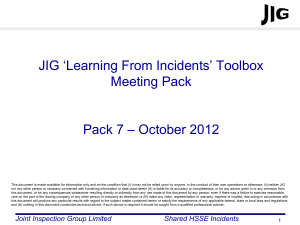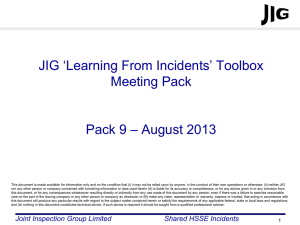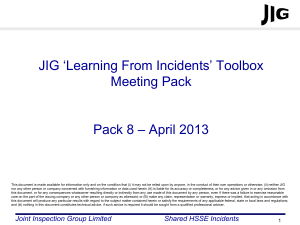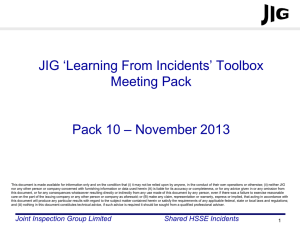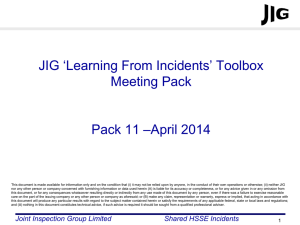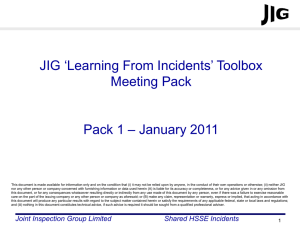JIG LFI Toolbox Pack 12 - Joint Inspection Group
advertisement
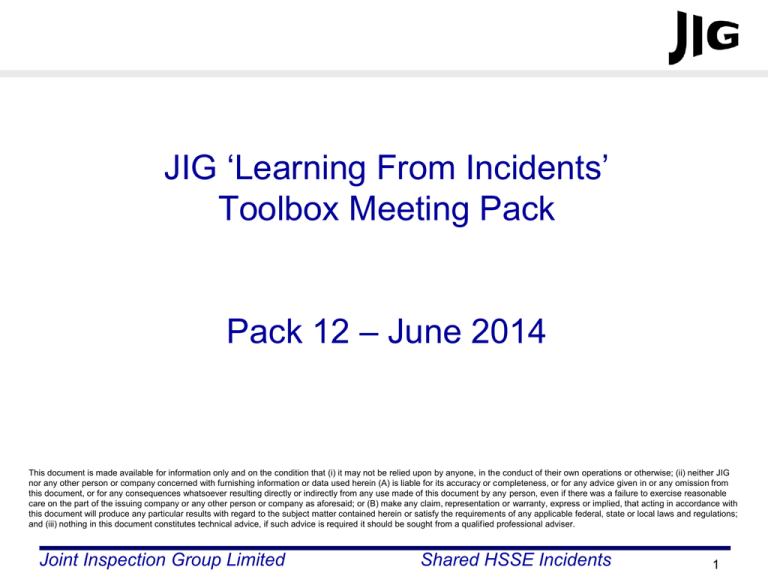
JIG ‘Learning From Incidents’ Toolbox Meeting Pack Pack 12 – June 2014 This document is made available for information only and on the condition that (i) it may not be relied upon by anyone, in the conduct of their own operations or otherwise; (ii) neither JIG nor any other person or company concerned with furnishing information or data used herein (A) is liable for its accuracy or completeness, or for any advice given in or any omission from this document, or for any consequences whatsoever resulting directly or indirectly from any use made of this document by any person, even if there was a failure to exercise reasonable care on the part of the issuing company or any other person or company as aforesaid; or (B) make any claim, representation or warranty, express or implied, that acting in accordance with this document will produce any particular results with regard to the subject matter contained herein or satisfy the requirements of any applicable federal, state or local laws and regulations; and (iii) nothing in this document constitutes technical advice, if such advice is required it should be sought from a qualified professional adviser. Joint Inspection Group Limited Shared HSSE Incidents 1 Learning From Incidents How to use the JIG ‘Learning From Incidents’ Toolbox Meeting Pack • The intention is that these slides promote a healthy, informal dialogue on safety between operators and management. • Slides should be shared with all operators (fuelling operators, depot operators and maintenance technicians) during regular, informal safety meetings. • No need to review every incident in one Toolbox meeting, select 1 or 2 incidents per meeting. • The supervisor or manager should host the meeting to aid the discussion, but should not dominate the discussion. • All published packs can be found in the publications section of the JIG website (www.jigonline.com) Joint Inspection Group Limited Shared HSSE Incidents 2 Learning From Incidents For every incident in this pack, ask yourselves the following questions: • What is the potential for a similar type of incident at our site? • How do our risk assessments identify and adequately reflect these incidents? • What prevention measures are in place and how effective are they (procedures and practices)? • What mitigation measures are in place and how effective are they (safety equipment, emergency procedures)? • What can I do personally to prevent this type of incident? Joint Inspection Group Limited Shared HSSE Incidents 3 Fuelling vehicle roll-away (runaway). (LFI 2014-05) Incident Summary – After fuelling a B737, the Operator drove the fuelling vehicle around the rear of the aircraft and stopped the vehicle on the other side of the aircraft. After approx 4 minutes, he then exited the cab and walked up the staircase to the cockpit with the required documentation to be signed. As soon as the Operator left the cab, the unattended fuelling vehicle started moving forward towards the front end of the aircraft. The vehicle was fitted with a seat interlock and this activated and stopped the vehicle after approx. 6 seconds but then dis-engaged, allowing the fuelling vehicle to move forward again. The Operator and Pilot observed this from the cockpit, and the Operator immediately ran down the staircase and brought the vehicle to a halt before any collision occurred with either passengers (who were boarding at the time) , or equipment. Causes – The Operator left the vehicle with the engine running and in gear, thinking he had fully applied the parking brake. The investigation found the handbrake was not fully engaged and hence an insufficient load was applied to the braking system. This, coupled with the vehicle being left in gear, caused the vehicle’s weight to overcome the net brake force resulting in the vehicle moving forward. The vehicle was fitted with a driver seat interlock designed to activate when an Operator leaves the cab. This activated after approximately 6 seconds, but then dis-engaged allowing the vehicle to travel further. Discussion Points – How do you establish a behaviour of leaving your vehicle in a safe condition when stopped? (In many cases of roll-away incidents the Operator has an established behaviour of not properly securing the vehicle and has had this behaviour reinforced countless times when nothing adverse was experienced. Then, one day, the Operator experiences a roll-away). What other factors do you think contribute to roll-aways? (e.g. Operators are in a hurry or taking short cuts). What are your site requirements for leaving a vehicle unattended, and how do ensure these are being followed? (e.g., Safety Walks) Discuss the importance of remaining vigilant on the apron at all times. Can you think of any similar situations that YOU have experienced or witnessed? Did you report it? Joint Inspection Group Limited Shared HSSE Incidents 4 Fuelling vehicle hits B777 left wing engine cowling (LFI 2014-06) Incident Summary – The accident occurred when fuelling a cargo B777 aircraft. Two fuelling vehicles were taking part in this operation, one under each wing of the aircraft. Operator 2 was initially instructed to fuel the left hand side and Operator 1 the right. However, Operator 2 arrived first and went to the right hand side. After the fuelling operation, Operator 1, who was positioned under the aircraft left wing (as shown on the diagram), drove away from the fuelling position. As he drove away the rear of the vehicle made contact with the aircraft engine cowling. Causes – Neither vehicle was positioned correctly, as both were left-hand drive and therefore approached the aircraft with a limited view of the engine. Operator 1 positioned his vehicle too close to the aircraft. When leaving the fuelling position Operator 1 turned left and did not take into account the sweeping effect of the rear part of his vehicle. As a result of this manoeuvre, the B777 left engine was first impacted by the rear part of the fuelling vehicle, with further damage to the cowling caused by contact with the red beacon on the fuelling vehicle. Discussion Points – How could the operators have approached and positioned their vehicles differently? How could a stand plan have helped to prevent this incident? (Consider aircraft type, vehicle access, configurations, stand design etc. See JIG 1, Issue 11, 6.2) Have you ever encountered any problems due to the proximity of the B777 fuelling adaptors to the engine? Can you think of any similar situations that YOU have experienced or witnessed ? Did you report it? Joint Inspection Group Limited Shared HSSE Incidents 5 JET A-1 Rail Tank Car Spill (LFI 2014-07) Incident Summary – The incident occurred during receipt of a Rail Tank Car (RTC) delivery of Jet A1. After six cars had been sampled and connected the Operator started the fuel pump. He then continued to sample and connect the remaining cars. Railcar number 10 was sampled and connected, and after a further three were connected, the Operator returned and noticed fuel dripping down on the far side of the train. He immediately cut the power to the pumps and saw that fuel was no longer dripping. He peered under the rail car, observing that fuel was now shooting out horizontally and landing approximately 10 feet away. He then closed the foot valve, halting the flow of fuel. Pressure caused the fuel to land 10 feet away and the Operator was too close to observe it immediately. Noise from the pumps and nearby road helped to mask the sound of the escaping fuel. The Operator used the fuel spill kit to contain as much fuel as possible. It is estimated that 400-1000 litres escaped during the time that the rail car was leaking. The Operator and Site Manager blanked off the damaged line and emptied the remainder of the train. They then proceeded to empty railcar 10 without further incident Causes – • The rail car sample point line at the far side of the train had been damaged, probably before arrival at the site, and was completely missing. • When the foot valve opened, fuel escaped through the damaged section. • The trajectory of the fuel, and noisy surroundings, prevented the Operator from noticing the spill immediately. Discussion Points – How serious could this incident have been? What checks do you carry out before all types of discharge operations (e.g. road vehicles, rail tank car, ship etc)? What handover procedures are there from transport operators to site staff? How can you inspect both sides of the RTCs, especially for long RTC sets? Has your Emergency Response Plan identified this risk and do you test this regularly? Can you think of any similar situations that YOU have experienced or witnessed? Did you report it? Joint Inspection Group Limited Shared HSSE Incidents 6 JET A-1 Tank Farm Spill (LFI 2014-08) Incident Summary – The night shift operator began to drain the filters and air eliminator vessel. At 01:30 he opened the Inlet & Outlet to each of the four vessels and opened the drain lines (8 valves all together). He also opened the main recirculation gate valve back to the tanks and turned on the recirculation pump. Under normal conditions all such draining activities start at around 04:30 before the morning shift. The operator had heard a radio communication on the “public frequency” that an emergency landing was expected so he decided to start the draining early so that he could be ready for the emergency and provide fuelling services if required. During draining, a radio communication started again about the possible emergency landing for medical reasons, which distracted the Operator. He stopped the pump but did not close any of the valves which meant that fuel from the tanks started draining under gravity into the product recovery tank. The product recovery tank overflow alarm started ringing during the night but the alarm sound was muted by the Operator. Although the alarm was muted, the signal light remained on and the Operator should have gone outside to investigate but he ignored the warning light. Causes – • • • • • The Operator left the drain valves open. The Operator broke his normal routine and started the draining early. The Operator was distracted. Alarm was disregarded and the alarm muted by the operator. Operator was unclear on what the alarms meant. Discussion Points – • • • • • How serious could this incident have been? What alarm procedures do you have in place and do you know what each alarm means? How do you handle repeat false alarms? How do you manage distractions? Do you undertake routine site walk rounds? Can you think of any similar situations that YOU have experienced or witnessed? Did you report it? Joint Inspection Group Limited Shared HSSE Incidents 7 Near Miss - Operator narrowly missed hitting leg on edge of vent cap (LFI 2014-09) Incident Summary – The Operator was walking on top of a Hydrant Valve Vault and very close to the cap of the valve vault vent pipe. He almost hit his leg on the sharp edge of the cap. The Operator reported the incident as a near miss. Causes – • The vent cap edge was found to be very sharp. • The layout of the site, design of the vent cap or site personnel did not consider potential injury by anyone passing by the vent cap. • The incident was investigated and it was decided to install, as a protection against personal injury, a flexible gasket around the edge of the vent cap. Discussion Points – • • • • • • What more could be done to prevent personal injury from impact with this vent cap? Do all Operators at your site report Near Miss (NM) and Potential Incidents (PI)? Are NM/PIs investigated and corrective actions taken and how are the findings reported back to the Operators? Are there any similar unsafe conditions in other Valve Vaults at your site? Are there any sharp edges in the vicinity of walking/working areas/walkways, etc? Are Operators trained in Hazard Awareness and do they use “Last Minute Risk Assessments” or other such basic self-risk assessments (assess the risk, analyze how to reduce it and act to ensure safe operation)? Joint Inspection Group Limited Shared HSSE Incidents 8
